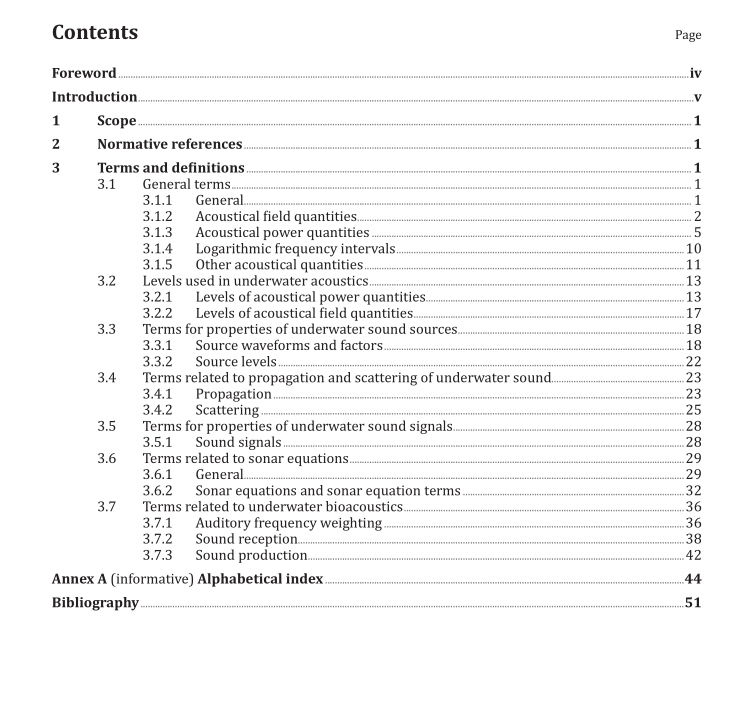BS ISO 18405:2017 pdf download.Underwater acoustics — Terminology.
This document defines terms and expressions used in the field of underwater acoustics, including natural, biological and anthropogenic (i.e. man-made) sound. It includes the generation, propagation and reception of underwater sound and its scattering, including reflection, in the underwater environment including the seabed (or sea bottom), sea surface and biological organisms. It also includes all aspects of the effects of underwater sound on the underwater environment, humans and aquatic life. The properties of underwater acoustical systems are excluded.
2 Normative references
There are no normative references in this document.
3? Terms? and? definitions
For the purposes of this document, the following terms and definitions apply.
ISO and IEC maintain terminological databases for use in standardization at the following addresses:
— IEC Electropedia: available at http://www.electropedia.org/
— ISO Online browsing platform: available at http://www.iso.org/obp
3.1 General terms
3.1.1 General
3.1.1.1 sound
alteration in pressure, stress or material displacement propagated via the action of elastic stresses in an elastic medium and that involves local compression and expansion of the medium, or the superposition of such propagated alterations
Note 1 to entry: The medium in which the sound exists is often indicated by an appropriate adjective, e.g.
airborne, water-borne, or structure-borne.
Note 2 to entry: In the remainder of this document, the medium is assumed to be a compressible fluid.
Note 3 to entry: A sound wave is a realization of sound.
Note 4 to entry: The word “sound” may also be used as part of a compound noun, in which case, it is a synonym of “acoustic”. For example, “acoustic pressure” and “acoustic power”’ are synonyms of sound pressure (3.1.2.1) and sound power (3.1.3.14).
[SOURCE: Reference [23] and Reference [35]]
3.1.1.2 ambient sound
sound (3.1.1.1) that would be present in the absence of a specified activity
Note 1 to entry: Ambient sound is location-specific and time-specific.
Note 2 to entry: In the absence of a specified activity, all sound is ambient sound
Note 3 to entry: Ambient sound includes ambient noise (3.1.5.11).
Note 4 to entry: Examples of specified activity include the act of measuring the underwater sound and the radiation of sound by specified sound sources.
Note 5 to entry: Ambient sound can be anthropogenic (e.g. shipping) or natural (e.g. wind, biota).
3.1.1.3 soundscape
<underwater acoustics> characterization of the ambient sound (3.1.1.2) in terms of its spatial, temporal and frequency attributes, and the types of sources contributing to the sound field
3.1.1.4 reverberation
sound (3.1.1.1) resulting from cumulative scattering of sound by an aggregation, or ensemble,of scatterers
Note 1 to entry: Reverberation commonly arises from scatterers in a volume or on a surface.
3.1.1.5 material element
sound particle
smallest element of the medium that represents the medium’s mean density
Note 1 to entry: The characteristic length scale of this element is of the order of several times the mean free molecular path (see Reference [22]).
3.1.2 Acoustical field quantities
3.1.2.1 sound pressure
p contribution to total pressure caused by the action of sound (3.1.1.1)
Note 1 to entry: Sound pressure is a function of time, which may be indicated by means of an argument t, as in p(t), where p is sound pressure and t is time.
Note 2 to entry: Sound pressure is expressed in pascals (Pa).
Note 3 to entry: The term “sound pressure” is sometimes used as a synonym of “root-mean-square sound pressure”. This use is deprecated.
Note 4 to entry: The term “sound pressure” is defined by IEC 60050 as the root-mean-square value of p(t). While this IEC definition is not compatible with the present (ISO) definition, users of ISO standards might nevertheless encounter the IEC definition, for example, in hydrophone calibration standards developed by the IEC.
Note 5 to entry: Weighted sound pressure is defined in 3.7.1.1.
[SOURCE: ISO 80000-8:2007, 8-9.1 and 8-9.2, modified]
3.1.2.2 sound pressure spectrum
P Fourier transform of the sound pressure (3.1.2.1)
Note 1 to entry: Sound pressure spectrum is a function of frequency, which may be indicated by means of an argument f, as in P(f), where P is sound pressure spectrum and f is frequency.BS ISO 18405 pdf download.BS ISO 18405:2017 pdf download
